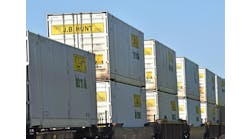Will the STB Railroad Reciprocal Switching Decision Really Help Shippers?
The Surface Transportation Board’s proposal to allow railroad reciprocal switching garnered immediate praise from shipper groups, but after shippers have a chance to examine it more closely, they might not be as happy.
The board issued its proposed rulemaking notice on July 27 and public comments are due on October 25. The STB acted in response to a request filed by the National Industrial Transportation League (NITL) in July 2011—exactly six years earlier.
Reciprocal switching is defined as the switching of a railcar between the interchange tracks of one railroad to a customer’s private or assigned siding on another railroad for the purpose of loading or unloading freight. It is needed by shippers with rail spur lines that go directly to their facilities.
Under the proposed rule a shipper requiring reciprocal switching must prove to the STB that the arrangement is in the public interest and needed for competitive rail service. The STB then would make its findings based on evidence presented by the shipper and the railroad. Also proposed are two alternative methods for the STB to set the access price paid by the new competing railroad to the main railroad if they can’t agree.
In announcing the new rule, STB chairman Daniel R. Elliott III declared, “I thank NITL for bringing their reciprocal switching proposal to the board for consideration, and I am pleased that today we are granting that petition in part.” NITL’s executive director Jennifer Hedrick was just as happy. “We applaud the STB’s decision to move forward on changes to competitive switching regulations,” she said.
The immediate response of Cal Dooley, president of the American Chemistry Council, was, “We welcome STB’s decision to move forward on competitive switching, which will help put the marketplace back in the driver's seat and improve the flow of goods throughout our economy.”
Although common practice in Canada for years where no problems have been reported, railroads in the United States have fought tooth and nail to prevent being required to provide this service. One motivation stems from their fear that this could be the first step onto the slippery slope of re-regulation of the industry.
In reaction to the STB action, Edward R. Hamberger, president of the Association of American Railroads (AAR), said, “The freight rail industry's position remains unchanged: forced access is an ill-conceived approach that compromises the efficiency of the entire network by gumming up the system through added interchange movements, more time and increased operational complexity.”
The proposal applies only to Class I railroads but the industry is so strong in its opposition that Congress only managed to pass rail reform legislation last year after a reciprocal switching provision was left out that had been included in an earlier version of the measure.
What should give shippers pause is that the STB’s proposal does little or nothing to change the actual procedures in place today. Instead of proposing a sweeping change that would mandate reciprocal switching across the country, shippers will still be required to file an individual petition with the board and make a case for gaining its approval in each and every situation where they need switching to take place. All the change does is shift the burden of proof.
The current rules allow a shipper to file a similar petition, but to win it needs to show competitive abuse perpetrated by its main railroad. Under the proposed rule the STB says it will order reciprocal switching if a shipper can show that either it would be practicable and in the public interest, or it is necessary to provide competitive rail service.
“Under the first path, the STB would balance the likely benefits of the switching arrangement against any detriments to the involved railroads. Under the second path, a shipper would need to establish that there are no effective competitive transportation alternatives available,” explain attorneys for the law firm of Thompson Hine.
But they point out that under the proposal railroads can counter with evidence that the proposed switching “is not feasible or is unsafe” or that the presence of such switching would “unduly hamper the ability of that carrier to serve its shippers.”
That sounds like a process that would require considerable amount of time, months at minimum and perhaps longer in a world where same-day deliveries are now common in the supply chain.
Under the previous STB reciprocal switching procedures exactly one case had been filed by a shipper seeking to secure reciprocal switching, and they gave up and withdrew after the case dragged on for 10 years, according to Paul Delp, president of Lansdale Warehouse Co. and the American Chain of Warehouses Inc.
One problem for shippers in opposing Class I carriers is that whether it involves fighting them in the halls of Congress or the hearing rooms of the STB, “you can never outspend the railroads,” observes Delp, who also serves as co-chairman of the Transportation Advisory Council (formerly the Rail Council) of the International Warehouse Logistics Association.




